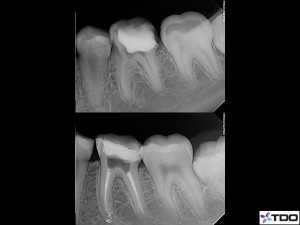But what exactly are we asking? What are we looking for? Why does the puff matter?
I don’t want to get too long and drawn out on this, but I can tell you that although I frequently have some extrusion of sealer, it is not a goal of mine. It is a byproduct of my cleaning and shaping technique COMBINED with the periapical architecture that is present at the time of obturation.
So what does that mean?
Vital and necrotic are frequently used terms when discussing the status of the dental pulp. These are not, however, static conditions.The process of pulpal necrosis is often accompanied by periapical tissue resorption. This can be a progressive process that starts occurring in real time as the pulp is necrosing. This can also not occur, leaving the periapical architecture intact, although the pulp is necrotic.
Think of obturation as showing you what your preparation looks like, as well as what the architecture of the periapex looks like.
There may or may not be a constriction present. The PDL may or may not be distended, and the pulpal complex may or may not exist in continuity with the periapex. As such, if you believe, as I do, that you prefer to have a layer of sealer at the apex, followed by a mass of gutta percha condensed into place in the hopes of obturating with a thin layer of sealer and a bulk of core material, extrusion will likely occur when using a vertical obturation technique. In combination with periapical resorption, you can get some large extrusions if you do not use caution and sometimes even if you do.
I don’t think about puffs. Some extrusions are larger, others don’t exist at all. As long as my management is on point and I control the case from start to finish, I am happy.
Here are some recent cases. Some puffy, some not. Even within the same tooth!
For those who are fans of golf:
Don’t watch the swing. Watch the ball. And in the end, the scorecard never lies.



